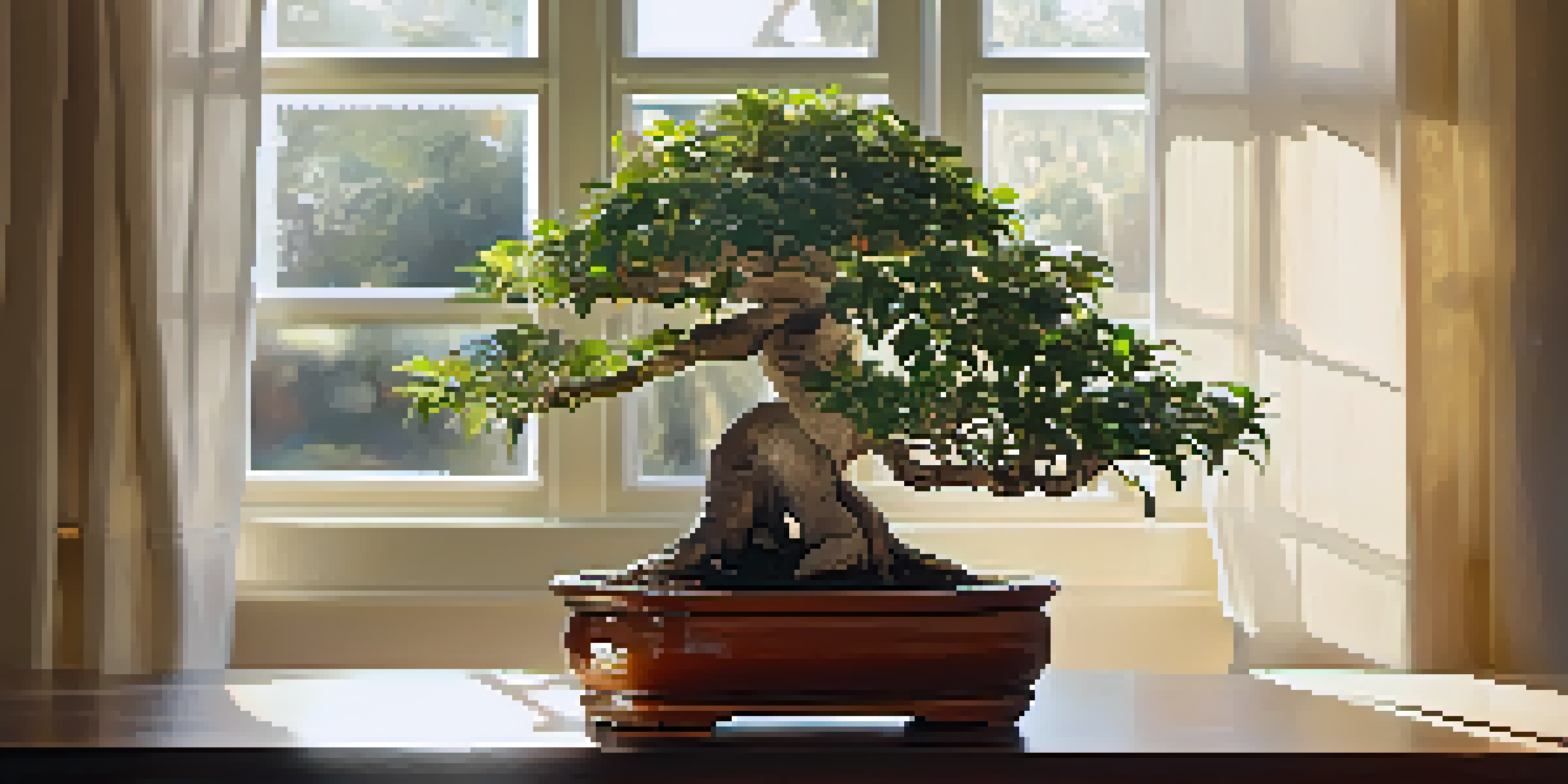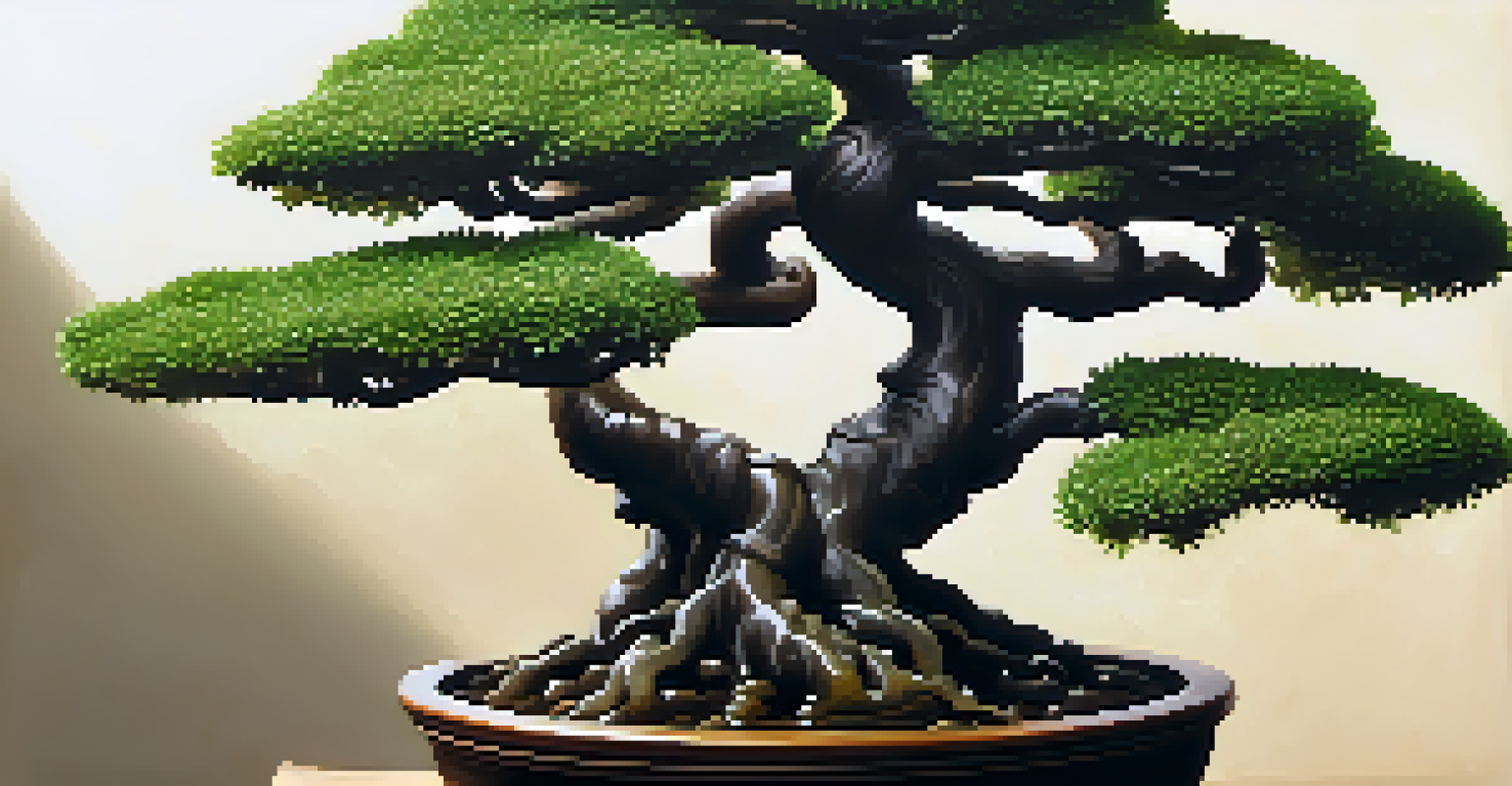Indoor vs. Outdoor Bonsai: Care Differences Explained

Understanding the Basics of Bonsai Types
Bonsai is an art form that involves cultivating miniature trees, creating a stunning representation of nature in a small pot. There are two main types of bonsai: indoor and outdoor. Each type has unique care requirements that cater to their specific environments.
The greatest gift of the garden is the restoration of the five senses.
Indoor bonsai typically consist of species that thrive in warmer, humid conditions, such as ficus or jade. Outdoor bonsai, on the other hand, usually feature species like juniper or pine, which can withstand seasonal changes. Understanding these basic distinctions is crucial for successful bonsai care.
In essence, choosing between indoor and outdoor bonsai shapes how you will care for your plant, from watering to sunlight exposure, making it the first step in your bonsai journey.
Light Requirements: Indoor vs. Outdoor
One of the most significant differences between indoor and outdoor bonsai is their light requirements. Indoor bonsai need bright, indirect light, as they’re often shielded from direct sunlight. A south-facing window is ideal for providing this gentle light.

Conversely, outdoor bonsai thrive in full sunlight, which helps them grow strong and healthy. They should receive at least six hours of direct sunlight daily, especially during the growing season. This difference means that placement is key in selecting the right environment for your bonsai.
Indoor vs. Outdoor Bonsai Care
Understanding the distinct care requirements for indoor and outdoor bonsai is essential for their health and growth.
Understanding these light needs ensures your bonsai stays vibrant and healthy, whether it's basking indoors or enjoying the great outdoors.
Watering Needs: Indoor and Outdoor Variations
Watering is another care aspect where indoor and outdoor bonsai diverge. Indoor bonsai generally require more frequent watering, as indoor air tends to be drier, especially in winter. Checking the soil moisture regularly is essential to prevent root rot or dehydration.
To plant a garden is to believe in tomorrow.
On the flip side, outdoor bonsai may need less frequent watering, as they benefit from natural rain. However, during dry spells or hot weather, you must monitor them closely to avoid drought stress. Understanding these watering nuances will keep your bonsai thriving.
By tailoring your watering practices to your bonsai's environment, you'll create the perfect conditions for growth and longevity.
Temperature Considerations for Each Type
Temperature plays a critical role in the health of your bonsai. Indoor bonsai are generally more tolerant of temperature fluctuations, but they should be kept away from drafts, heaters, or air conditioning vents. Ideal indoor temperatures range from 60°F to 75°F.
Outdoor bonsai, however, are exposed to the elements and require more attention to seasonal changes. They need a dormancy period in colder months, which means protecting them from frost and extreme temperatures. Knowing how to regulate temperature for each type is vital for their survival.
Light and Water Needs Differ
Indoor bonsai thrive in bright, indirect light and require more frequent watering, while outdoor bonsai need direct sunlight and can benefit from natural rain.
By creating a stable environment that aligns with your bonsai's needs, you set the stage for a flourishing plant.
Humidity Levels: A Key Factor in Care
Humidity is essential for bonsai health, particularly for indoor varieties. Indoor bonsai thrive in higher humidity levels, which can be achieved through misting or using a humidity tray filled with water and pebbles. This mimics their natural tropical habitats and supports their growth.
Outdoor bonsai typically enjoy the natural humidity of their environment, making them less dependent on additional moisture. However, during excessively dry summer months, keeping an eye on humidity levels is still beneficial. Understanding how to manage humidity can make a significant difference.
By addressing humidity needs, you can enhance the vitality of your bonsai, whether it’s inside your home or outside in the garden.
Fertilization Practices: Indoor vs. Outdoor
Fertilization is vital for keeping your bonsai healthy and vibrant. Indoor bonsai usually require more frequent fertilization since they have limited soil nutrients. Using a balanced fertilizer every couple of weeks during the growing season helps support their growth.
Outdoor bonsai benefit from the nutrients in the natural soil, but they also need regular feeding. A slow-release fertilizer applied in spring can provide a steady supply of nutrients throughout the growing season. Being aware of these differences ensures you’re meeting their specific needs.
Pruning and Fertilization Practices
Adjusting pruning and fertilization techniques based on whether your bonsai is indoors or outdoors is crucial for promoting robust growth.
By adjusting your fertilization practices according to your bonsai's environment, you can promote lush foliage and robust growth.
Pruning Techniques for Indoor and Outdoor Bonsai
Pruning is vital for shaping your bonsai and promoting healthy growth. Indoor bonsai pruning can be done more frequently, as they tend to grow faster in controlled environments. Regular trimming helps maintain their size and encourages bushier growth.
Outdoor bonsai, however, might require seasonal pruning to account for their natural growth cycles. This includes understanding when to prune for the best results, often in late winter or early spring before new growth begins. Knowing the right timing and techniques for each type of bonsai is crucial.

By mastering pruning techniques, you’ll be able to create a stunning bonsai that reflects your artistic vision.
Conclusion: Choose the Right Bonsai for You
In conclusion, understanding the care differences between indoor and outdoor bonsai is essential for any enthusiast. Each type has distinct requirements for light, water, temperature, humidity, fertilization, and pruning. By recognizing these differences, you can make informed decisions that cater to your bonsai's needs.
Whether you opt for the comforting presence of an indoor bonsai or the robust beauty of an outdoor one, both offer a unique gardening experience. Connecting with your bonsai can be a fulfilling journey that brings nature closer to your home.
Ultimately, your choice should reflect your lifestyle and the environment you can provide, ensuring that your bonsai thrives for years to come.